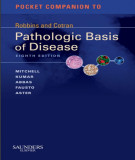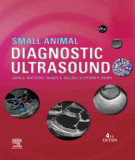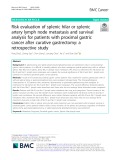
Spleen and lymph nodes
-
Part 2 book "Atlas of adult autopsy" includes content: Lymphoreticular tissues - lymph node, spleen and thymus, bone and marrow; endocrine glands - thyroid, parathyroid, adrenal, and pituitary; the central nervous system, with eye and ear; standard and special tests; devices - foreign items encountered during the autopsy; the forensic autopsy; the radiological autopsy; toxicology.
 168p
168p  zizaybay1101
zizaybay1101
 30-04-2024
30-04-2024
 2
2
 2
2
 Download
Download
-
Part 1 book "Pocket companion to Robbins cotran pathologic basis of disease" includes content: Cellular responses to stress and toxic insults; acute and chronic inflammation; tissue renewal, regeneration, and repair; hemodynamic disorders, thromboembolic disease and shock; genetic disorders; diseases of the immunesystem; neoplasia; infectious diseases; environmental and nutritional diseases; diseases of infancy and childhood, blood vessels, the heart, diseases of white blood cells, lymph nodes, spleen and thymus.
 353p
353p  muasambanhan10
muasambanhan10
 06-04-2024
06-04-2024
 3
3
 0
0
 Download
Download
-
Part 2 ebook "Small animal diagnostic ultrasound" includes content: Liver, spleen, pancreas, pancreas, peritoneal fluid, lymph nodes, masses, peritoneal cavity, and great vessel thrombosis, musculoskeletal system, adrenal glands, urinary tract, prostate and testes, prostate and testes.
 350p
350p  muasambanhan07
muasambanhan07
 08-02-2024
08-02-2024
 4
4
 0
0
 Download
Download
-
Part 2 book "Atlas of small animal diagnostic imaging" includes content: Mediastinum, cardiovascular system, feline thorax, anatomy, variants, and interpretation paradigm, pancreas, urogenital tract, extraabdominal structures and the abdominal body wall, adrenal glands and lymph nodes, the peritoneal and retroperitoneal space, hepatobiliary imaging, spleen, gastrointestinal tract
 424p
424p  muasambanhan01
muasambanhan01
 13-12-2023
13-12-2023
 9
9
 2
2
 Download
Download
-
Part 2 book "Diagnostic radiology in small animal practice" includes content: General abdomen; liver, spleen, lymph nodes and pancreas; digestive tract (including contrast procedures); urogenital tract (including contrast procedures); general principles of orthopaedic radiology; congenital and developmental bone and joint diseases; acquired bone and joint diseases; fractures; birds; small mammals; reptiles.
 251p
251p  oursky07
oursky07
 23-10-2023
23-10-2023
 4
4
 2
2
 Download
Download
-
The present study was aimed for studying gross and histopathological changes in various organs of STZ-NAD induced Type –II diabetic rat model. In diabetic group rats, the gross changes included congestion in liver, kidneys, heart and brain, atrophic changes in liver, heart, pancreas, spleen, thymus, testes and epididymes, edematous mesenteric lymph nodes and ulcerations in gastrointestinal tract in comparison to control group.
 6p
6p  angicungduoc5
angicungduoc5
 14-06-2020
14-06-2020
 15
15
 0
0
 Download
Download
-
As splenectomy and spleen-preserving lymphadenectomy are performed only in some proximal gastric cancer patients, it is difficult to identify patients who have undergone radical gastrectomy with or without splenic hilar (No.10) or splenic artery (No.11) lymph node metastases.
 10p
10p  vikuala271
vikuala271
 13-06-2020
13-06-2020
 16
16
 1
1
 Download
Download
-
It remains controversial whether prophylactic No.10 lymph node clearance is necessary for gastric cancer. Thus, the present study aims to investigate the impact of prophylactic No.10 lymph node clearance on the perioperative complications and prognosis of upper and middle third gastric cancer.
 8p
8p  vijakarta2711
vijakarta2711
 09-06-2020
09-06-2020
 14
14
 1
1
 Download
Download
-
(bq) part 1 book "differential diagnosis in ultrasound imaging" presents the following contents: vessels, liver, biliary tree and gallbladder (biliary tree, gallbladder), spleen, lymph nodes.
 272p
272p  thangnamvoiva6
thangnamvoiva6
 19-07-2016
19-07-2016
 66
66
 6
6
 Download
Download
-
(BQ) Part 2 book "Essentials of general surgery" presents the following contents: Trauma, burns, abdominal wall, including hernia, esophagus, stomach and duodenum, small intestine and appendix, colon, rectum and anus, pancreas, liver, breast, surgical endocrinology, spleen and lymph nodes, diseases of the vascular system, transplantation, surgical oncology: malignant diseases of the skin and soft tissue.
 658p
658p  thangnamvoiva2
thangnamvoiva2
 25-06-2016
25-06-2016
 47
47
 1
1
 Download
Download
-
(BQ) Continued part 1, part 2 of the document High-Yield histopathology presents the following contents: Lymph node, spleen, esophagus and stomach, small intestine, large intestine, liver and gallbladder, exocrine pancreas and islets of langerhans, respiratory system, urinary system, hypophysis, thyroid, parathyroid,... Invite you to consult.
 194p
194p  thangnamvoiva2
thangnamvoiva2
 23-06-2016
23-06-2016
 34
34
 2
2
 Download
Download
-
It may also infiltrate different organs, including liver, spleen, lymph nodes, CNS, kidneys, and gonads. Treatment options for patients with acute leukemia include chemotherapy, radiation therapy, targeted therapy, immunotherapy and stem cell or bone marrow transplantation. Finding a cure is a realistic goal for both ALL and AML, especially in younger patients. However, long-term survival is reachable in about one half of patients with acute lymphoblastic leukemia and in the minority of patients with acute myeloid leukemia.
 582p
582p  ti_du_hoang
ti_du_hoang
 10-08-2012
10-08-2012
 54
54
 1
1
 Download
Download
-
This chapter is intended to serve as a guide to the evaluation of patients who present with enlargement of the lymph nodes (lymphadenopathy) or the spleen (splenomegaly). Lymphadenopathy is a rather common clinical finding in primary care settings, whereas palpable splenomegaly is less so. Lymphadenopathy Lymphadenopathy may be an incidental finding in patients being examined for various reasons, or it may be a presenting sign or symptom of the patient's illness.
 19p
19p  socolanong
socolanong
 25-04-2012
25-04-2012
 59
59
 3
3
 Download
Download
-
The clinical evaluation of patients with myeloma includes a careful physical examination searching for tender bones and masses. Only a small minority of patients has an enlargement of the spleen and lymph nodes, the physiologic sites of antibody production. Chest and bone radiographs may reveal lytic lesions or diffuse osteopenia. MRI offers a sensitive means to document extent of bone marrow infiltration and cord or root compression in patients with pain syndromes. A complete blood count with differential may reveal anemia. Erythrocyte sedimentation rate is elevated.
 7p
7p  thanhongan
thanhongan
 07-12-2010
07-12-2010
 98
98
 7
7
 Download
Download
-
The absence of the spleen has minimal long-term effects on the hematologic profile. In the immediate postsplenectomy period, leukocytosis (up to 25,000/µL) and thrombocytosis (up to 1 x 106/µL) may develop, but within 2–3 weeks, blood cell counts and survival of each cell lineage are usually normal.
 7p
7p  konheokonmummim
konheokonmummim
 03-12-2010
03-12-2010
 72
72
 2
2
 Download
Download
-
Differential Diagnosis Many of the diseases associated with splenomegaly are listed in Table 60-2. They are grouped according to the presumed basic mechanisms responsible for organ enlargement: 1.
 6p
6p  konheokonmummim
konheokonmummim
 03-12-2010
03-12-2010
 112
112
 4
4
 Download
Download
-
The differential diagnostic possibilities are much fewer when the spleen is "massively enlarged," palpable more than 8 cm below the left costal margin or its drained weight is ≥1000 g (Table 60-3). The vast majority of such patients will have non-Hodgkin's lymphoma, chronic lymphocytic leukemia, hairy cell leukemia, chronic myelogenous leukemia, myelofibrosis with myeloid metaplasia, or polycythemia vera.
 5p
5p  konheokonmummim
konheokonmummim
 03-12-2010
03-12-2010
 76
76
 3
3
 Download
Download
-
Approach to the Patient: Splenomegaly Clinical Assessment The most common symptoms produced by diseases involving the spleen are pain and a heavy sensation in the LUQ. Massive splenomegaly may cause early satiety. Pain may result from acute swelling of the spleen with stretching of the capsule, infarction, or inflammation of the capsule. For many years it was believed that splenic infarction was clinically silent, which at times is true.
 5p
5p  konheokonmummim
konheokonmummim
 03-12-2010
03-12-2010
 70
70
 2
2
 Download
Download
-
Splenomegaly Structure and Function of the Spleen The spleen is a reticuloendothelial organ that has its embryologic origin in the dorsal mesogastrium at about 5 weeks' gestation. It arises in a series of hillocks, migrates to its normal adult location in the left upper quadrant (LUQ), and is attached to the stomach via the gastrolienal ligament and to the kidney via the lienorenal ligament. When the hillocks fail to unify into a single tissue mass, accessory spleens may develop in around 20% of persons. The function of the spleen has been elusive.
 5p
5p  konheokonmummim
konheokonmummim
 03-12-2010
03-12-2010
 73
73
 2
2
 Download
Download
-
Laboratory Investigation The laboratory investigation of patients with lymphadenopathy must be tailored to elucidate the etiology suspected from the patient's history and physical findings. One study from a family practice clinic evaluated 249 younger patients with "enlarged lymph nodes, not infected" or "lymphadenitis." No laboratory studies were obtained in 51%. When studies were performed, the most common were a complete blood count (CBC) (33%), throat culture (16%), chest x-ray (12%), or monospot test (10%).
 5p
5p  konheokonmummim
konheokonmummim
 03-12-2010
03-12-2010
 86
86
 2
2
 Download
Download
CHỦ ĐỀ BẠN MUỐN TÌM
































